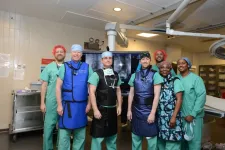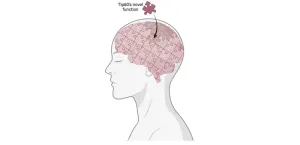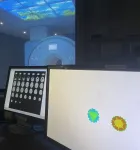(Press-News.org) A common and widely used chemical may be fueling the rise of the world’s fastest growing brain condition – Parkinson’s disease. For the past 100 years, trichloroethylene (TCE) has been used to decaffeinate coffee, degrease metal, and dry clean clothes. It contaminates the Marine Corps base Camp Lejeune, 15 toxic Superfund sites in Silicon Valley, and up to one-third of groundwater in the U.S. TCE causes cancer, is linked to miscarriages and congenital heart disease, and is associated with a 500 percent increased risk of Parkinson’s disease.
In a hypothesis paper in the Journal of Parkinson’s Disease, an international team of researchers—including University of Rochester Medical Center (URMC) neurologists Ray Dorsey, MD, Ruth Schneider, MD, and Karl Kieburtz, MD—postulate that TCE may be an invisible cause of Parkinson’s. In the paper they detail the widespread use of the chemical, the evidence linking the toxicant to Parkinson’s, and profile seven individuals, ranging from a former NBA basketball player to a Navy captain to a late U.S. Senator, who developed Parkinson’s disease either after likely working with the chemical or being exposed to it in the environment.
A ubiquitous and widespread industrial pollutant
TCE was a widely used solvent employed in a number of industrial, consumer, military, and medical applications, including to remove paint, correct typewriting mistakes, clean engines, and anesthetize patients. Its use in the U.S. peaked in the 1970’s, when more than 600 million pounds of the chemical—or two pounds per American—were manufactured annually. Some 10 million Americans worked with the chemical or other similar industrial solvents. While domestic use has since fallen, TCE is still used for degreasing metal and spot dry cleaning in the U.S.
TCE contaminates countless sites across the country. Half of the most toxic Environmental Protection Agency’s Superfund sites contain TCE. Fifteen sites are in California’s Silicon Valley where the chemicals were used to clean electronics and computer chips. TCE is found in numerous military bases, including Camp Lejeune in North Carolina. From the 1950s to the 1980s a million Marines, their families, and civilians that worked or resided at the base were exposed to drinking water levels of TCE and perchloroethylene (PCE), a close chemical cousin, that were up to 280 times above what is considered safe levels.
TCE and Parkinson’s disease
The connection between TCE and Parkinson’s was first hinted at in case studies more than 50 years ago. In the intervening years, research in mice and rats have shown that TCE readily enters the brain and body tissue and at high doses damages the energy-producing parts of cells known as mitochondria. In animal studies, TCE causes selective loss of dopamine-producing nerve cells, a hallmark of Parkinson’s disease in humans.
Individuals who worked directly with TCE have an elevated risk of developing Parkinson’s. However, the authors warn that “millions more encounter the chemical unknowingly through outdoor air, contaminated groundwater, and indoor air pollution.”
The chemical can contaminate soil and groundwater leading to underground rivers, or plumes, that can extend over long distances and migrate over time. One such plume associated with an aerospace company on Long Island, New York, is over four miles long and two miles wide, and has contaminated the drinking water of thousands. Others are found everywhere from Shanghai, China, to Newport Beach, California.
Beyond their risks to water, the volatile TCE can readily evaporate and enter people’s homes, schools, and work places, often undetected. Today, this vapor intrusion is likely exposing millions who live, learn, and work near former dry cleaning, military, and industrial sites to toxic indoor air. Vapor intrusion was first reported in the 1980s when radon was found to evaporate from soil and enter homes and increase the risk of lung cancer. Today millions of homes are tested for radon, but few are for the cancer-causing TCE.
Decades before symptoms appear
The piece profiles seven individuals where TCE may have contributed to their Parkinson’s disease. While the evidence linking TCE exposure to Parkinson’s disease in these individuals is circumstantial, their stories highlight the challenges of building the case against chemical. In these cases, decades have often passed between exposure to TCE and the onset of Parkinson’s symptoms.
The case studies include the professional basketball player Brian Grant, who played for 12 years in the NBA, and was diagnosed with Parkinson’s at age 36. Grant was likely exposed to TCE when he was three years old and his father, then a Marine, was stationed at Camp Lejeune. Grant has created a foundation to inspire and support people with the disease.
Amy Lindberg was similarly exposed to the contaminated drinking water at Camp Lejeune while serving as a young Navy captain and would go on to be diagnosed with Parkinson’s disease 30 years later. The piece details others whose exposure was the result of living close to a contaminated site or working with the chemical, including the late U.S. Senator Johnny Isakson, who stepped down from office after a Parkinson’s diagnosis in 2015. Fifty years earlier, he served in the Georgia Air National Guard, which used TCE to degrease airplanes.
Addressing the threat to public health
The authors note that “for more than a century, TCE has threatened workers, polluted the air we breathe—outside and inside—and contaminated the water we drink. Global use is waxing, not waning.”
The authors proscribe a series of actions to address the public health threat posed by TCE. They note that contaminated sites can be successfully remediated and indoor air exposure can be mitigated by vapor remediation systems similar to those used for radon. However, the U.S. alone is home to thousands of contaminated sites and this process of cleaning and containment must be accelerated.
They argue for more research to better understand how TCE contributes to Parkinson’s and other diseases. TCE levels in groundwater, drinking water, soil, and outdoor and indoor air require closer monitoring and this information needs to be shared with those who live and work near polluted sites.
In addition, the authors call for finally ending the use of these chemicals in the U.S. PCE is still widely used today in dry cleaning and TCE in vapor degreasing. Two states, Minnesota and New York, have banned TCE, but the federal government has not, despite findings by the EPA as recently at 2022 that the chemicals pose “an unreasonable risk to human health.”
Additional authors include the paper’s co-first author, Maryam Zafar, now a student at the Harvard T.H. Chan School of Public Health, Samantha Lettenberger, Meghan Pawlik, and Dan Kinel with URMC, Bastiaan Bloem and Myrthe Frissen with Radboud University Medical Centre in the Netherlands, Caroline Tanner and Samuel Goldman with the University of California-San Francisco, and Briana De Miranda with the University of Alabama at Birmingham.
END
Common dry cleaning chemical linked to Parkinson’s
2023-03-14
ELSE PRESS RELEASES FROM THIS DATE:
Molecular component of caffeine may play a role in gut health
2023-03-14
Brigham researchers studying how and why certain cell types proliferate in the gut found that xanthine, which is found in coffee, tea and chocolate, may play a role in Th17 differentiation
Insights may help investigators better understand gut health and the development of conditions such as inflammatory bowel disease
The gut is home to a cast of microbes that influence health and disease. Some types of microorganisms are thought to contribute to the development of inflammatory conditions, such as inflammatory bowel disease (IBD), but the exact cascade of events that leads from microbes to immune cells to disease remains ...
Ochsner Health announces new Aortic Center; subscribes to cutting-edge imaging with Cydar Technology
2023-03-14
NEW ORLEANS, La. – Global death rates from aortic diseases have steadily increased over the past two decades. Studies show up to 8% of individuals will develop an aortic aneurysm during their lifetime, higher than rates of colon and lung cancer combined, and over 80% of ruptured aortic aneurysms cause sudden death.
To save lives and improve outcomes for patients with aortic disease of all kinds, Ochsner Health is excited to announce the establishment of The Ochsner Aortic Center. Outfitted with cutting-edge imaging technology that allows medical staff to make faster, easier, and safer decisions, this dedicated, comprehensive aortic center is now the ...
Aston Pharmacy School researchers develop new technique mixing oil and water to improve drug delivery
2023-03-14
A team of researchers from Aston University has developed a new technique that could be a game changer for the medical and drinks industries.
The technology enables insoluble drug/oil to be dissolved in water. The technique is novel because it doesn’t just mix the two together to make an emulsion, it makes oil soluble in water and has the potential to revolutionise a variety of medical treatments and improve drug delivery.
The technique was developed with Max Bio+ a spin out company founded by Professor Sunil Shah, a consultant ...
New guideline introduces recommendations for optimal timing of elective hip or knee arthroplasty
2023-03-14
ATLANTA — The American College of Rheumatology (ACR) and the American Association of Hip and Knee Surgeons (AAHKS) released a summary of its new guideline titled “the Optimal Timing of Elective Hip or Knee Arthroplasty for Patients with Symptomatic Moderate to Severe Osteoarthritis or Osteonecrosis Who Have Failed Nonoperative Therapy.” The ACR and AAHKS have worked together before, creating guidelines for Perioperative Management of Antirheumatic Medication in Patients with Rheumatic Diseases Undergoing Elective Total Hip or Total Knee Arthroplasty in 2017 and 2022. While those guidelines focus on which medications ...
Solving the Alzheimer’s disease puzzle: One piece at a time
2023-03-14
Researchers from Drexel University have uncovered a novel regulatory mechanism in the brain that is essential for making the right kinds of proteins that promote healthy brain function, and its malfunctioning may be an early contributor of the development of Alzheimer’s disease.
Brain cells are continuously undergoing changes in response to environmental stimuli and to record new memories. Such complex brain capability relies on the ability of brain cells to generate different functional variants of the same protein using a process known as alternative RNA splicing.
Recent studies have reported defects ...
Stephen Fantone elected chair of Hertz Foundation’s board of directors
2023-03-14
The Fannie and John Hertz Foundation, a nonprofit organization dedicated to empowering the most promising innovators in science and technology, has announced the election of Stephen D. Fantone as chair of its board of directors.
Fantone is the founder and president of Optikos Corporation, which provides innovative applications of optical technology, both products and services, to commercial, government and consumer products organizations worldwide. Fantone is a recognized expert in optical engineering and optical product ...
WVU lab’s game-changing high-performance semiconductor material could help slash heat emissions
2023-03-14
Researchers at West Virginia University have engineered a material with the potential to dramatically cut the amount of heat power plants release into the atmosphere.
A team led by Xueyan Song, professor and George B. Berry Chair of Engineering at the Benjamin M. Statler College of Engineering and Mineral Resources, has created an oxide ceramic material that solves a longstanding efficiency problem plaguing thermoelectric generators. Those devices can generate electricity from heat, including power plant heat emissions, which contribute to global warming.
The breakthrough ...
William Evans joins Hertz Foundation board of directors
2023-03-14
The Fannie and John Hertz Foundation, a nonprofit organization dedicated to empowering the most promising innovators in science and technology, has announced the election of William Evans to its board of directors.
Evans is the physics division leader in the Physical and Life Sciences Directorate at Lawrence Livermore National Laboratory (LLNL), which works to enable United States security and global stability and resilience by empowering multidisciplinary teams to pursue bold and innovative science and technology.
“It is imperative that the Hertz Foundation’s board of directors ...
COVID-19 pandemic has long-lasting effects on adolescent mental health and substance use
2023-03-14
March 14, 2023-- The COVID-19 pandemic has had a long-lasting impact on adolescent mental health and substance use according to a new population-based study are based on survey responses from a nationwide sample of over 64,000 13–18-year-old North American and Icelandic adolescents assessed prior to and up to two years into the pandemic. The study was conducted by faculty at Columbia University Teachers College and Mailman School of Public Health and a team of Icelandic and other North American clinical, behavioral and social scientists. The findings are published in published in The Lancet Child & Adolescent Health.
This same research team ...
Learning behavior differs between OCD and problem gambling
2023-03-14
Shinsuke Suzuki at The University of Melbourne, Australia reports distinct patterns of reward-seeking behavior between obsessive compulsive disorder (OCD) and problem gambling, in a study publishing in the open access journal PLOS Biology on March 14th. OCD is associated with lower-than-normal learning rates when rewards are less than expected. On the other hand, people with problem gambling exhibit boosted and blunted learning from rewards higher and lower than expected, respectively.
Understanding the differences between obsessive and addictive behaviors is essential for developing treatments for conditions like problem gambling ...




